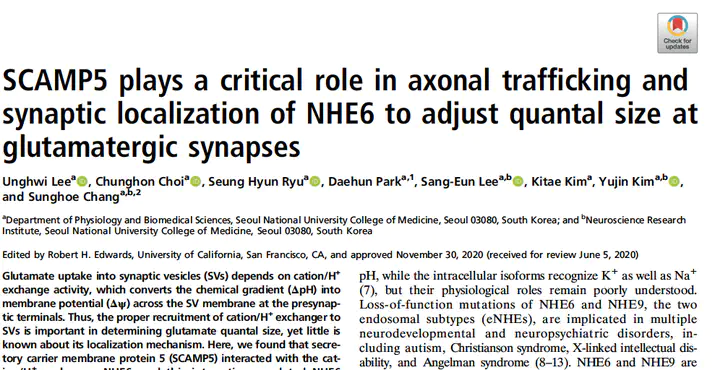SCAMP5 plays a critical role in axonal trafficking and synaptic localization of NHE6 to adjust quantal size at glutamatergic synapses
 Image credit: PNAS
Image credit: PNAS
Abstract
Glutamate uptake into synaptic vesicles (SVs) depends on cation/H+ exchange activity, which converts the chemical gradient (ΔpH) into membrane potential (Δψ) across the SV membrane at the presynaptic terminals. Thus, the proper recruitment of cation/H+ exchanger to SVs is important in determining glutamate quantal size, yet little is known about its localization mechanism. Here, we found that secretory carrier membrane protein 5 (SCAMP5) interacted with the cation/H+ exchanger NHE6, and this interaction regulated NHE6 recruitment to glutamatergic presynaptic terminals. Protein-protein interaction analysis with truncated constructs revealed that the 2/3 loop domain of SCAMP5 is directly associated with the C-terminal region of NHE6. The use of optical imaging and electrophysiological recording showed that small hairpin RNA-mediated knockdown (KD) of SCAMP5 or perturbation of SCAMP5/NHE6 interaction markedly inhibited axonal trafficking and the presynaptic localization of NHE6, leading to hyperacidification of SVs and a reduction in the quantal size of glutamate release. Knockout of NHE6 occluded the effect of SCAMP5 KD without causing additional defects. Together, our results reveal that as a key regulator of axonal trafficking and synaptic localization of NHE6, SCAMP5 could adjust presynaptic strength by regulating quantal size at glutamatergic synapses. Since both proteins are autism candidate genes, the reduced quantal size by interrupting their interaction may underscore synaptic dysfunction observed in autism.
Supplementary notes can be added here, including code, math, and images.